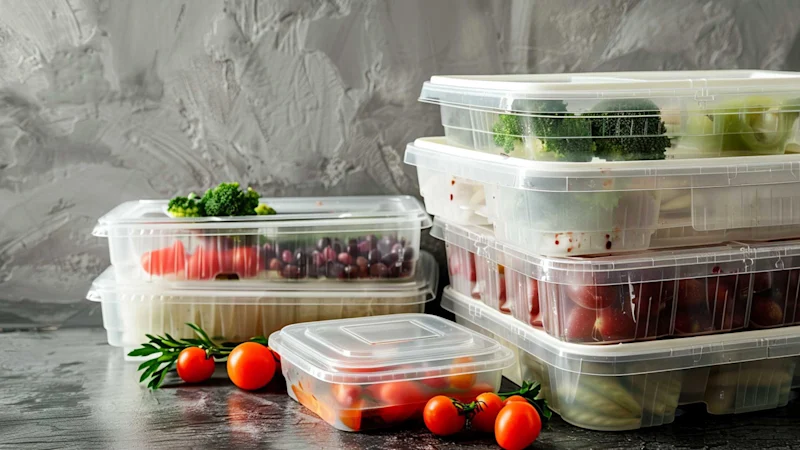
EFSA Review Questions Extent of Microplastic Release from Food Contact Materials
EFSA finds limited evidence of microplastic release from food contact materials, citing mechanical stress as the main mechanism and calling for improved methodologies.


The European Commission has issued a groundbreaking ban on Bisphenol A (BPA) in food contact materials, citing its significant health risks. This regulation, adopted on 19 December 2024, reflects the EU’s commitment to prioritising public health and food safety.
Bisphenol A (BPA) is a chemical widely used in the production of plastics, resins, and coatings. It is a common component in the linings of food cans, reusable drink bottles, water coolers, and various other kitchenware. BPA is valued for its ability to enhance durability, resistance, and heat tolerance in materials that come into contact with food and beverages.
Despite its functional uses, BPA can migrate into food and beverages, particularly under conditions of high heat or acidity. This migration exposes consumers to potentially harmful amounts of the chemical.
The European Food Safety Authority (EFSA) has identified severe adverse effects of BPA on the immune system. In its 2023 scientific review, EFSA concluded that even minimal exposure could compromise immune function, increasing susceptibility to infections and diseases.
BPA is classified as an endocrine disruptor, meaning it interferes with the body's hormone system. This can lead to reproductive health issues, developmental delays in children, and hormonal imbalances. EFSA also linked BPA to adverse effects on foetal development during pregnancy.
In 2023, EFSA reduced the tolerable daily intake (TDI) for BPA by 20,000 times, lowering it to just 0.2 nanograms per kilogram of body weight. This unprecedented reduction highlights the chemical’s severe risks to human health, even at previously deemed "safe" exposure levels.
BPA-based resins and varnishes are widely used as internal coatings for metal food and beverage cans. These coatings prevent corrosion and contamination, ensuring the safety and longevity of the packaged products.
BPA is a key component in the production of polycarbonate plastics, used for items such as reusable water bottles, storage containers, and baby feeding bottles. These items often come into prolonged contact with food or drink, increasing the likelihood of BPA leaching.
BPA is also present in water coolers and large-scale water filtration systems. These systems, critical in food and beverage industries, rely on BPA for its strength and durability, particularly under high-pressure and high-temperature conditions.
The ban follows extensive consultations with Member States, public stakeholders, and a rigorous scientific review by EFSA. The evidence from EFSA’s studies demonstrated that BPA exposure far exceeds the newly established TDI, posing significant health concerns for all age groups.
The regulation prohibits BPA in any food contact materials, including coatings, plastics, and adhesives. It also restricts other hazardous bisphenols, such as Bisphenol S (BPS), which has been identified as similarly harmful to human health.
The regulation provides an 18-month transition period for most products, allowing industries time to identify and adopt safer alternatives. This phased approach minimises disruption in the food supply chain.
Certain applications, such as polysulfone filtration membranes and large-capacity tanks, are exempt under strict conditions. These items are critical in food production and currently lack viable alternatives. However, businesses must ensure BPA migration into food is undetectable, adhering to Good Manufacturing Practices (GMP).
The shift away from BPA poses significant challenges for industries reliant on its chemical properties. Replacing BPA requires extensive research and development to identify materials that meet similar performance standards for durability, heat resistance, and food safety.
To ensure accountability, large manufacturers must report progress on developing BPA-free solutions. While this requirement excludes small and medium-sized enterprises (SMEs), it places the onus on larger companies to lead innovation in safer food contact materials.
The ban on BPA signifies a critical step in the EU’s broader agenda to reduce harmful chemicals in everyday products. It also aligns with global efforts to address endocrine-disrupting chemicals and protect vulnerable populations, including infants and pregnant women.
Oliver Várhelyi, the EU Commissioner for Health and Animal Welfare, lauded the regulation:
“Maintaining high food safety standards is one of the Commission’s highest priorities. Today’s ban, which is based on solid scientific advice, will protect our consumers against harmful chemicals where they can come into contact with their food and drink.”
The EU’s decisive action on BPA reflects its unwavering commitment to public health. By prioritising the development of BPA-free alternatives and enforcing strict compliance measures, the regulation sets a new standard for food safety. While challenges remain for businesses, the transition to safer materials is a necessary step in protecting consumers from harmful chemical exposure. The phased implementation balances safety with practicality, ensuring a smooth transition for industry and consumers alike.
Foresight continuously tracks 1000s of sources and maps updates to your portfolio:




EFSA finds limited evidence of microplastic release from food contact materials, citing mechanical stress as the main mechanism and calling for improved methodologies.

Germany's CONMAR-Impact study sets new environmental quality standards for TNT in marine ecosystems, raising industry-wide compliance questions.

EU Member States urge the Commission to accelerate the REACH revision, citing urgent health, environmental, and industry competitiveness needs.
Subscribe to Foresight Weekly and get the latest insights on regulatory changes affecting chemical compliance.
Free forever. Unsubscribe anytime.
Read by professionals at